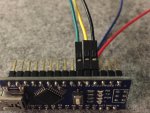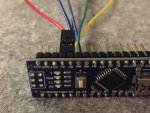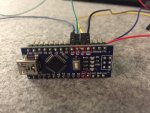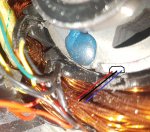well, almost I guess

a) where's the color sequence, you just posted that same image again,
this time as a screen shot (which is in fact LESS helpfull)
b) you wrapped the black wire in shrink as well
(too bad, now we lost the negative easy access terminal)
since battery is not a good source! (leave it as is please...)
c) I can't see much on your crowded bench..
the red probe is conencted properly, but where's the black one?
I sincerely hope it's the one you hold in the second pic and
that that's the HE conenctor. (can't tell for sure

)
If it is, we're golden.. 658 is a perfectly reasonable value to read!
(and the resistors are of a good enough precision and in correct order.. leave them shrinkwrapped as they are)
if however you used any other than the HE connector as a ground for your multimeter probe,
the value might be off (unlikely by much so I'm still willing to call it good.. but I'm not exactly happy

)
yes I said you want 700.. but remember I asked you about the exact value for the HE power connectors?
and you just replied with a roundabout 5V?
that's a direct result

No worries.. all good

BUT this is important:
you really need to take care in this next step,
don't wing it, don't rush it, and be -for the sake of your personal health- careful what you do!
make sure your kid isn't coming "helping dad" inadvertently touching anything... what can severly harm an adult, does worse to younger thinner skinned humanoids!
rather bark her off than have her hurt!
draw yourself a phase table
exactly like that please:
Code:
black - red black - red black - red
|yellow / green |green / blue |blue / yellow
-------------------------------------------------------
none | | |
-------------------------------------------------------
yellow | | |
-------------------------------------------------------
green | | |
-------------------------------------------------------
blue | | |
Now, take the gaffa tape,
and tape down the motor phase wires to your table, take care that they're well spread out
(20 cm or more) so you cannot accidentally touch two with one hand.
This is important!
any mishap with a powered up phase you short with your hand can cause a severe electrical burn.. (wear rubberized gloves if you have)
reconnect the battery (ideally wrap the connectors in gaffa too),
connect the patch cable as before (taking power from the HE connector itself)
engage the powerswitch (or bridge) to power the controller up.
Set your multimeter to 200V DC and
- clamp it's black probe to the yellow and
the red one to the green phase wire.
- if you now read a voltage already, write it down in the
"none" - row (add a sign for voltage direction!)
- now take one of the red output wires of our patch cable
and connect it to the yellow wire on the HE connector.
write down the Voltage (again directionally signed)
- move the patch output wire to the green on the HE connector, write the Voltage down
- finally move it on to the blue wire on the HE conenctor and write down the voltage
- remove the red probe from the green phase wire and move it to the blue phase wire,
then move the black probe to the green
and repeat the steps a-d for the second column
- move the red probe to the yellow phase wire,
then the black to the blue phase wire and repeat a-d for the third column
if all you got was zero volts all the way.. not all is lost,
we just need to trick the controller into thinking we have a throttle signal.
if you got a voltage on all three columns at least once
you can stop here and just show me the table.
Else draw another such phase table if yours is now filled with zeros
(sorry for the hassle I was hoping for a minimal signal on the phases)
write down 0.7V throttle at some corner to not mess the two tables up.
take that second output wire of our patch cable and connect it to the signal wire on the throttle connector (should be green I think), that way we fake a low throttle signal (nothing close to full power but surely detectable)
ideally tape the throttle connector and that patch cable output down too,
so it cannot come loose while we use the other output wire to repeat the above steps all over again.
and then take a snapshot of that table to show me the results.
Make sure to disconnect the controller from the battery (safety first and such)
I think we can now make a good call about the state of the controller already.
chances are slim but not impossible that we got a weird result
(one phase working the other ones not or such)
but that might be just based on us not treating the controller as a motor would and it got slightly confused by our pokings

if so we might need to conduct a second experiment alike
just way more complicated..
so please - for now- leave the phase wires taped down to the bench

'sid





























